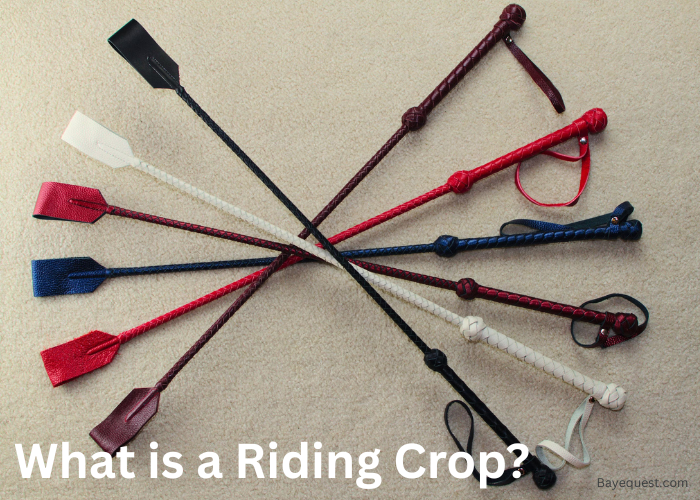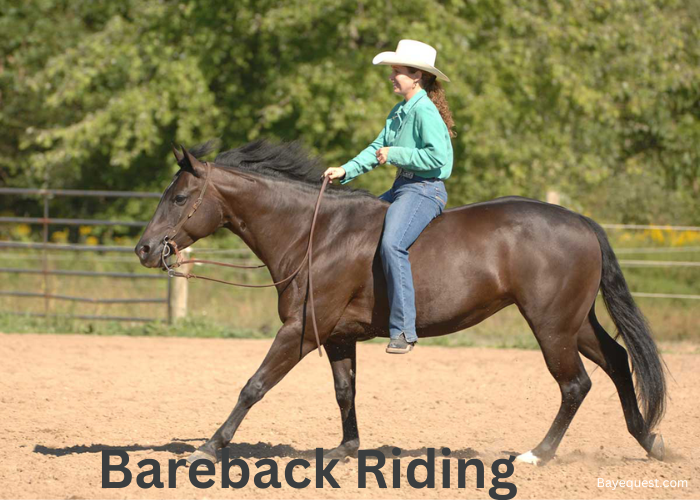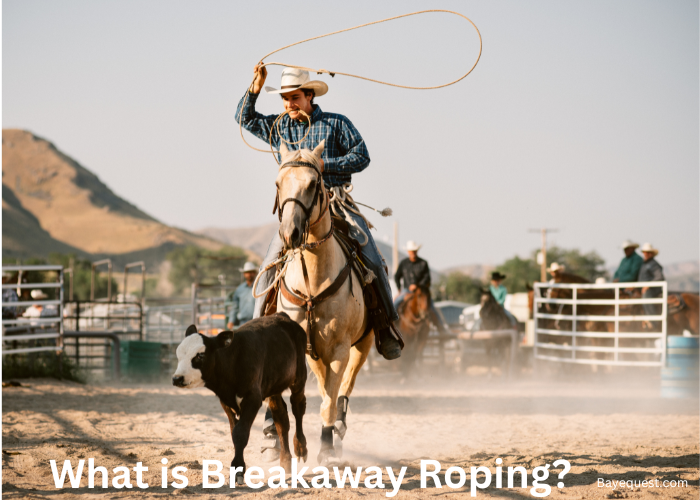When you think of horseback riding, saddles and reins probably come to mind. But there’s another tool riders use. Small, sharp, and surprisingly important, it’s called a riding crop.
More than just a stick, it’s a communication tool between horse and rider. When used correctly, it’s gentle, precise, and powerful.
A tap here. A cue there. It helps guide a horse without shouting or pulling.
Want to know how a simple crop can change an entire ride? Let’s dive into the fascinating world of riding crops and why they matter more than you think.
What is a Riding Crop?
A riding crop is a short, flexible tool used by horseback riders. It’s designed to reinforce the rider’s commands, not to punish the horse.
Most riding crops have a sturdy shaft, a comfortable handle, and a small flap at the end called a keeper. When used properly, a crop gives a light tap to encourage the horse to move forward or stay focused.
It’s a way for the rider to communicate quickly and clearly. Riding crops are common in disciplines like jumping, eventing, and general riding.
They help build better timing, balance, and trust between horse and rider.
History, Origin, and Evolution of Riding Crops
The riding crop has a long and interesting history. Its roots trace back to ancient civilizations where horses were key to transport, farming, and battle.
Early riders needed tools to guide their horses quickly without hurting them. Simple sticks and flexible branches were the first “crops.”
Over time, these tools evolved into something more refined.
By the Middle Ages, riders used short whips made from leather and wood. These early crops were symbols of both control and skill.
Nobility often carried beautifully crafted riding whips as a mark of status.
In the 18th and 19th centuries, as horseback riding became a sport and a pastime, riding crops became even more specialized. They were shorter, lighter, and designed for precise communication rather than force.
Today’s riding crops blend tradition with modern materials like fiberglass and nylon. They remain a vital tool, not for punishment, but for partnership between horse and rider.
Interesting read: Is Horseback Riding a Sport or a Hobby?
Basic Parts of a Riding Crop
A riding crop might look simple, but every part has a purpose. Here’s what makes up a typical crop:
Handle. The part you hold. It’s often wrapped for better grip and balance. Some handles have a small cap or knob at the end to keep the crop from slipping out of your hand.
Shaft. The main body of the crop. It’s firm but flexible, usually made from fiberglass, carbon fiber, or strong plastic. It needs to be sturdy enough to deliver a quick, clear tap.
Keeper. A small loop or flap at the end of the shaft. It spreads the impact over a wider area to make taps gentle, not sharp. The keeper also makes the tap more noticeable without hurting the horse.
Wrist Loop. Some crops have a wrist strap for extra security. It helps you keep hold of the crop even if your hand slips.
Materials Used in Riding Crops
Riding crops are crafted using a smart blend of materials, chosen for strength, flexibility, and comfort. The shaft, which forms the body of the crop, is often made from fiberglass or carbon fiber.
Fiberglass gives it toughness and a slight flex, while carbon fiber offers a lighter, stronger feel that many professional riders prefer.
In some traditional crops, the shaft may even be made of polished wood, giving a classic look and a heavier hand-feel.
Handles, which are built for grip and balance, might be wrapped in fine leather or coated with rubber or textured synthetic materials.
Some high-end crops combine wood cores with leather wrapping, blending beauty and performance.
The keeper, the small flap at the tip, is usually made from leather or a strong synthetic fiber.
Leather keepers give a soft, traditional contact, while synthetic versions offer more durability and weather resistance. Some crops also include a wrist loop, made of either leather or nylon, to help riders keep a secure hold.
Overall, modern riding crops combine centuries of tradition with the best of today’s materials.
Purpose of a Riding Crop
The main purpose of a riding crop is communication. It’s not about punishment, it’s about clarity.
Riders use a crop to back up their natural aids, like their legs or voice. When a horse doesn’t respond to a cue, a light tap with the crop helps reinforce the message.
It tells the horse, “Pay attention,” or “Move forward,” without causing fear or pain.
A riding crop is also used to sharpen a horse’s focus. If a horse gets distracted or lazy, a quick, gentle tap reminds them to stay engaged.
It’s a tool for precision, helping riders fine-tune the horse’s movements without pulling or forcing.
In jumping, crops encourage quick responses at takeoff. In dressage, they help polish small corrections.
In general riding, they build better communication and trust between horse and rider.
When used properly, a crop becomes an extension of the rider’s body: calm, respectful, and effective.
Types of Riding Crops
There are different types of riding crops, each designed for a specific style of riding. Here’s a closer look:
Standard riding crop
A standard riding crop is the most common type used across general riding disciplines. It’s usually around 24 to 30 inches long, with a firm but flexible shaft and a soft keeper at the end.
The main purpose of a standard crop is to back up the rider’s natural aids, such as the legs or seat, with a gentle, controlled tap.
It helps communicate direction, speed, or attention without relying solely on rein pressure.
Most beginner riders start with this type because it’s lightweight, easy to handle, and suitable for everyday training or hacking.
Jumping crops
Jumping crops are designed for show jumping, cross-country, and eventing disciplines. They are shorter and thicker than standard crops, usually between 20 to 26 inches in length.
The shorter design makes them quick to use without shifting hand position, which is crucial when a rider needs full control while approaching or clearing jumps.
Jumping crops often have a broader, padded keeper to deliver a stronger cue if needed without causing pain.
They are ideal for giving an extra burst of encouragement at critical moments, especially when a horse hesitates before a fence.
Trotting and driving/carriage whips
Trotting and driving whips are longer than riding crops, often stretching 48 inches or more, depending on the setup.
These whips are built for carriage driving and trotting disciplines, where the rider (or driver) sits behind the horse.
Because of the distance, the extra length allows the driver to reach the horse’s shoulder, hindquarters, or side without leaving the seat.
Unlike riding crops used for quick taps, carriage whips are used for very light touches, helping to steer or encourage movement with precision.
They are designed to be very flexible, ensuring smooth and subtle contact rather than sudden or harsh cues.
Dressage whips
Dressage whips are long, slim, and finely balanced, often between 39 to 43 inches in length. In dressage, the whip acts as an extension of the rider’s arm, allowing for precise, minimal corrections without shifting body position.
Rather than delivering strong taps, the dressage whip provides delicate cues along the horse’s side. This is to encourage impulsion, straightness, or lateral movements.
It’s often used during advanced schooling exercises, helping refine responsiveness without breaking the horse’s rhythm.
Proper use demands skill and restraint, as the goal is to enhance the horse’s performance gently, never forcefully.
Hunting crops
Hunting crops are rugged, heavy-duty tools developed for fox hunting and outdoor field riding. Unlike other crops, hunting crops often feature a solid shaft with a strong leather-wrapped handle and a hook or crook at the end.
This hook was traditionally used to open and close gates without dismounting or to hold onto branches when riding through dense countryside.
The shaft is sturdy enough to withstand outdoor hazards like thorns, mud, and rough terrain.
While not commonly used outside of hunting today, the hunting crop remains a symbol of traditional riding and fieldwork.
How to Use a Riding Crop
Using a riding crop properly is all about timing, technique, and respect for the horse. A crop is not a tool for punishment, it’s a tool for communication.
When used correctly, it encourages better performance without causing fear or pain.
First, you hold the riding crop in the same hand as your reins, usually across the inside of your wrist. It rests against your thigh, ready for quick use without distracting you or upsetting your horse’s balance.
Some riders prefer switching it between hands depending on which side of the horse they are working on, especially in advanced training.
The most common way to use a crop is to give a light, quick tap just behind the rider’s leg. This reinforces the rider’s natural aids, like squeezing with the legs or asking for more energy.
The tap should be clear but gentle enough to get the horse’s attention, not to hurt or startle them. If your horse doesn’t respond to your leg cue, the crop reminds them to move forward or stay attentive.
Timing is also critical. The tap should come immediately after the original cue with your leg or seat.
This way, the horse connects the crop with the original request, not with confusion or fear.
In disciplines like jumping or dressage, the crop can also fine-tune a horse’s movements.
For example, a soft tap might encourage better impulsion when approaching a jump or help sharpen a turn during a dressage test.
Always stay calm and consistent. A crop should never be used out of frustration or anger.
Horses are sensitive animals. They learn best through clear, fair communication.
If you’re unsure how to use a crop correctly, work with a qualified instructor to develop good habits early on.
When used with skill and kindness, a riding crop becomes an extension of the rider’s voice: quiet, clear, and purposeful.
How to Choose the Right Riding Crop
Choosing the right riding crop depends on your discipline, your horse’s needs, and your own comfort. A good crop feels like a natural extension of your hand, not too heavy, not too light, and easy to control.
First, think about your riding style.
If you’re jumping, a shorter, sturdier crop is ideal because it’s easier to use quickly without shifting your balance.
For dressage, you’ll want a longer, more flexible whip that allows subtle cues without needing to move your hands.
For general schooling or trail riding, a standard riding crop offers the best balance between length, strength, and ease of use.
Next, consider the horse.
Some horses are very sensitive and respond to even the lightest touch. In that case, you’ll want a crop with a soft keeper that delivers a gentle tap.
If your horse tends to be sluggish or easily distracted, a slightly firmer crop might be more effective for reinforcing your aids.
Weight and balance matter, too.
A well-balanced crop should feel steady and comfortable in your hand, without tipping forward or dragging backward.
It should be light enough to carry for long periods but solid enough to give clear, quick signals when needed.
Handle grip is another important factor.
If you ride in wet or humid conditions, a rubber or textured handle can prevent slipping.
For more traditional looks, leather-wrapped handles are popular, especially in formal riding disciplines.
Lastly, pay attention to quality.
Crops made from strong materials like fiberglass, carbon fiber, or reinforced plastic last longer and perform better.
While it’s tempting to choose based on color or design, always prioritize function and feel over style.
How to Care for Your Riding Crop
Taking care of your riding crop helps it last longer and perform better. Like any piece of riding equipment, a little regular maintenance goes a long way.
First, always store your crop properly. Avoid throwing it into the bottom of a tack trunk or leaving it bent in awkward shapes.
Over time, pressure and bad storage can weaken the shaft or warp its shape. The best place to store a crop is hanging vertically or lying flat in a dry, cool area.
Moisture is the enemy of most riding crops, especially those with leather parts. After riding, wipe down the shaft and keeper with a dry or slightly damp cloth to remove dirt, sweat, or mud.
If your crop has a leather handle or leather keeper, occasionally condition the leather using a good-quality leather balm. This keeps it supple and prevents cracking.
Avoid soaking your riding crop or exposing it to heavy rain whenever possible. Water can weaken glues, warp the shaft, and damage leather.
If it does get wet, dry it slowly at room temperature, never near direct heat, which can cause materials to shrink or crack.
Also, inspect your crop regularly for signs of wear. Check the keeper for fraying, the shaft for cracks, and the handle for loose fittings.
A small problem caught early is much easier (and cheaper) to fix than letting damage worsen over time.
Lastly, treat your crop with respect during rides. Don’t slam it against hard surfaces, use it to poke at objects, or treat it roughly.
Remember, a well-cared-for crop stays reliable, balanced, and safe in your hands for many rides to come.
Common Mistakes to Avoid When Using a Riding Crop
1. Using the crop out of anger. Striking out of frustration only teaches fear and damages trust. The crop should always be used calmly and thoughtfully.
2. Overusing the crop. Tapping too often makes the horse dull to your aids. Use the crop sparingly, only when necessary to reinforce a cue.
3. Poor timing. A delayed tap confuses the horse instead of clarifying your request. The crop should follow the original cue immediately for clear communication.
4. Hitting too hard. Heavy blows can hurt, scare, or break the horse’s confidence. A light, quick tap is all that’s needed to encourage better behavior.
5. Tapping the wrong area. The correct spot is just behind your leg. Avoid hitting the horse’s flank, head, or sensitive areas.
6. Ignoring your other aids. A crop should support your seat, legs, and voice, not replace them. Always use natural aids first, then follow up with the crop if necessary.
7. Using an ill-fitting crop. An ill-fitting crop that’s too long, short, or heavy makes riding awkward. Pick one that matches your discipline, riding style, and comfort level.
8. Letting the crop flop around. A loose, uncontrolled crop can accidentally hit your horse or distract them. Hold it securely and use it with intention.
9. Not practicing proper technique. An awkward swing or careless use can confuse your horse. Practice under a trainer’s guidance to develop smooth, effective movements.
10. Forgetting to reward good behavior. When your horse responds correctly after a tap, release pressure and reward them. Positive reinforcement helps your horse learn faster and stay confident.
Ethical Considerations of Riding Crops
The use of riding crops has long sparked debate within the equestrian world. At the heart of the discussion is one question: Is it ethical to use a tool that causes discomfort to another living being, even if used lightly?
Many riders and trainers argue that a crop, when used correctly, is a communication tool and not a punishment device.
A quick, light tap can clarify a rider’s cue without causing harm or distress. In this view, the crop is simply an extension of the rider’s natural aids.
However, animal welfare organizations often raise concerns. They point out that even mild use of a crop introduces an element of physical correction.
Misuse, whether intentional or accidental, can cause fear, pain, or emotional stress in horses.
Because horses cannot verbally communicate their feelings, it becomes the rider’s ethical responsibility to be hyper-aware of their reactions and well-being.
Competitive sports also face ethical scrutiny. Some governing bodies, like the FEI (Fédération Équestre Internationale) and national riding organizations, have introduced strict regulations about how and when crops can be used in competition.
For example, many events limit the number of times a horse can be struck and penalize riders for excessive or inappropriate use. These rules exist to protect horses, but they also raise the question: If restrictions are needed, does that suggest a deeper problem with the tool itself?
Another ethical layer is about alternatives. Good training methods prioritize groundwork, natural aids, and trust-building before introducing artificial aids like crops.
Riders are increasingly challenged to ask: Are there kinder, more horse-centered ways to achieve the same results without ever needing a crop?
Ultimately, ethical use comes down to respect, self-awareness, and skill. A riding crop should never be used to dominate, frighten, or force submission.
It should be used, if at all, with a clear purpose, fair timing, and genuine compassion for the horse’s physical and emotional welfare.
FAQs
Are riding crops safe for horses?
Riding crops are safe for horses when used correctly. They are designed to reinforce the rider’s natural cues, not to punish or harm the horse. A light, well-timed tap behind the rider’s leg helps clarify communication without causing pain. However, misuse, such as hitting too hard or using the crop out of anger, can hurt the horse physically and emotionally.
When should you replace your riding crop?
You should replace your riding crop if you notice any signs of damage. Cracks in the shaft, a loose or broken keeper, or a worn-out handle can affect how the crop performs. If the crop becomes bent, heavy, or uncomfortable to hold, it’s time for a replacement.
Conclusion
A riding crop is more than a tool. It’s a way to speak clearly to your horse. When used with skill and kindness, it builds trust, not fear.
Choosing the right crop and using it properly makes all the difference. It’s about timing, patience, and understanding your horse’s needs.
Good riders never rely on force. They use the crop as a quiet reminder, not a punishment.
Respect, care, and clear communication always come first. Master that, and the riding crop becomes a true partner in your journey.







